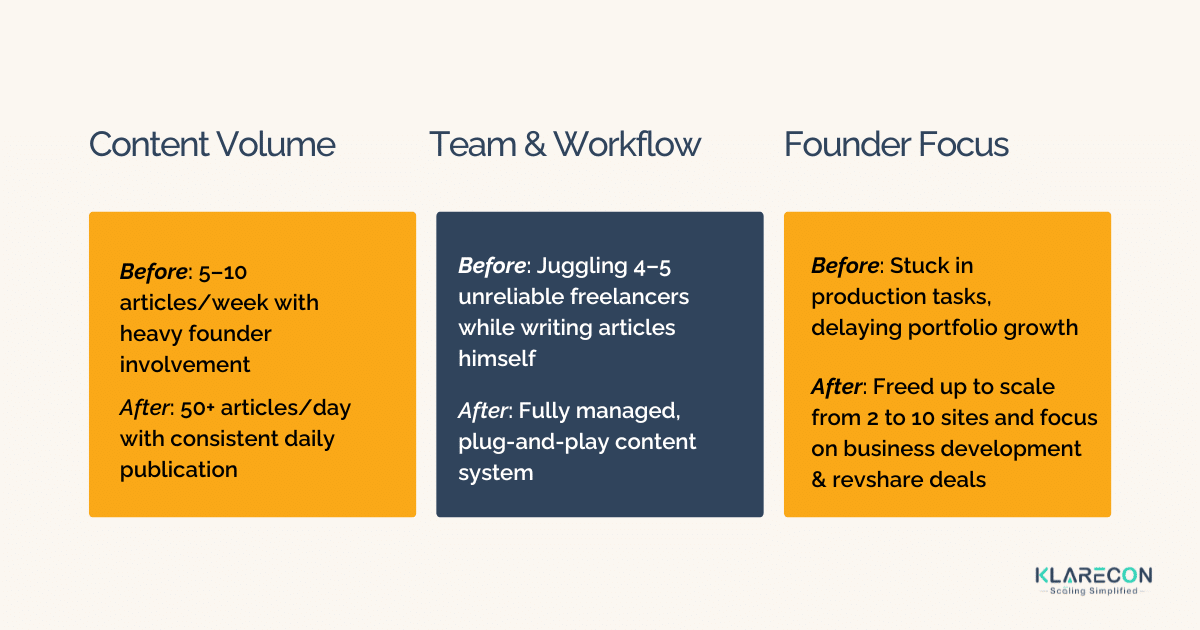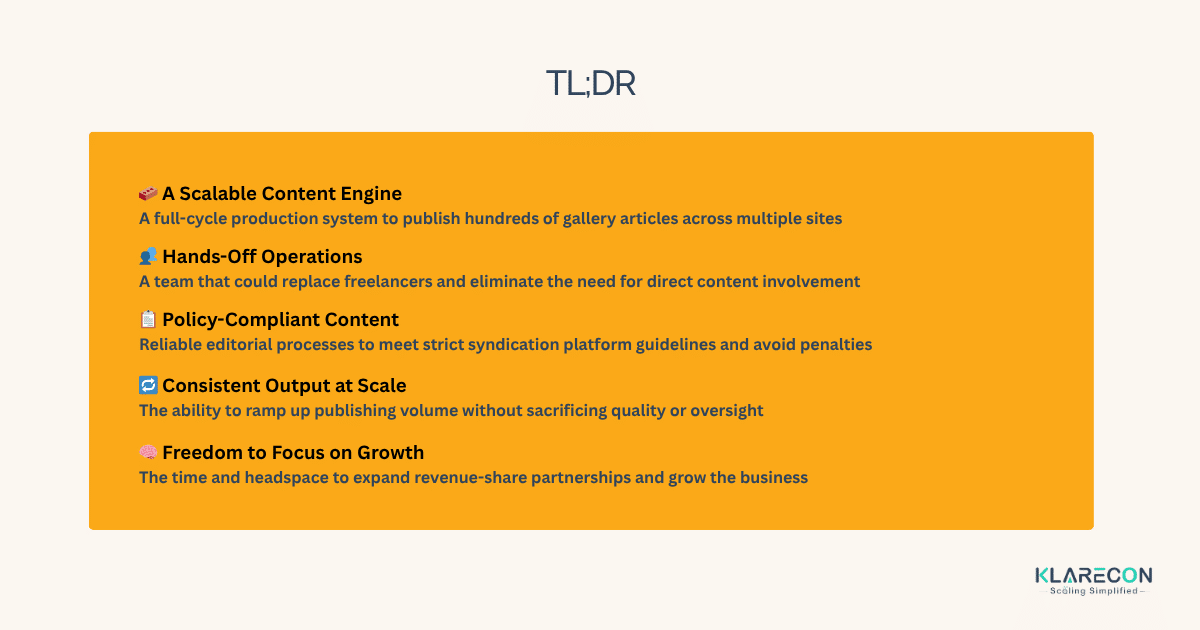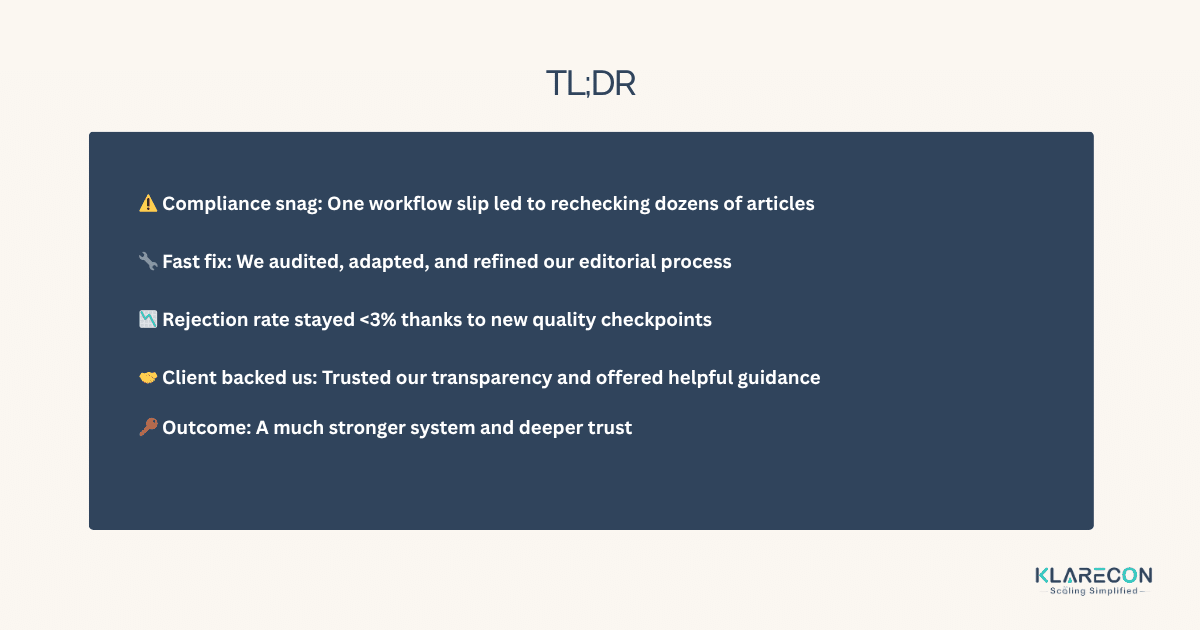Summary
In just 9 months, this solo publisher grew from managing 2 websites to 10 — without hiring a single full-time employee. By replacing inconsistent freelancers with Klarecon’s scalable system, he ramped up to 1000 gallery articles per month, secured his publishing pipeline, and redirected his focus to building a high-value revenue-share business.

About the client
The client has been active in the content space for over 7 years. Around two years ago, he became one of the early adopters of a major content syndication program. His goal was ambitious: to build a diverse portfolio of content sites spanning niches like lifestyle, travel, sports, cars, history, animals, entertainment, and relationships.
In parallel, he aimed to establish revenue-share partnerships with other publishers by providing them with the platform and support needed to join the same syndication program.
What the client needed

How Klarecon achieved the client’s goals
1. Built a Fully Managed Content Pipeline
We took over the entire content production process—from ideation to publishing—so the client could step away from day-to-day execution. Our team handled topic planning, writing, editing, image sourcing, compliance checks, and CMS uploads.
2. Replaced a Fragmented Team With a Scalable System
Instead of relying on scattered freelancers, we assigned a dedicated, quality-controlled team that could scale output as the client’s site count and content volume grew.
3. Integrated Syndication Policy Compliance Into Workflow
Given the strict rules of the content syndication platform, we built editorial checkpoints to catch policy issues before publishing. As we learned from early missteps, we refined the workflow to keep rejection rates under 3%.
4. Enabled High-Volume Publishing at Speed
We built and refined processes that allowed the client to grow from 5-10 articles/week to 1000+/month without in-house hiring. We adjusted output levels as his portfolio expanded, delivering fast without sacrificing quality.
5. Became a Thought Partner, Not Just a Service Provider
We approached communication as a shared system, not just updates—and that made all the difference.
Whether it was aligning on quality benchmarks, syncing on timelines, or flagging issues that needed his support, we insisted on keeping him in the loop without overwhelming him.
This built trust and helped the partnership thrive. While he remained hands-off in execution, he stayed plugged in where it mattered most, especially when solving technical issues or making business-critical decisions.
Hiccups

While the partnership delivered impressive results, the road to high-volume, policy-compliant publishing wasn’t without its bumps. One particularly challenging moment came early on when a specific misstep in our editorial workflow triggered a platform compliance concern. It forced us to manually re-check dozens of published articles — a time-consuming but necessary move.
At that point, we were still learning the finer nuances of the syndication platform’s rigid content policies. While our team already had processes in place, this incident exposed gaps that needed tightening.
Our goal had always been to keep the rejection rate below 3%, and this moment tested that ambition.
After a deep audit, we found few actual misses on our end—fortunately—but we still took it as a critical learning opportunity. We acted quickly, restructured part of the workflow, and embedded additional policy checkpoints into our production cycle.
What made this hiccup even more meaningful was the client’s response.
As we owned the mistake and proactively brought it to his attention, he showed full support and offered tactical suggestions, which helped us tackle the situation in a more organized manner without stopping new production.
While it was a painful few days, it became a turning point. The experience deepened mutual trust, made our processes sharper, and ultimately positioned us to scale with even greater confidence.
Where we are now
Our work today goes beyond supporting the client’s own portfolio of websites.
We now also produce content for his revenue-share partners — publishers who lack the in-house capacity to scale on their own. By leveraging our scaling efficiencies, the client has been able to extend his syndication platform to others and offer a turnkey content solution.
In addition, he has tapped into our capabilities for content repurposing, including text-to-video transformation, which helps him explore new formats and channels for revenue growth.
Use case
- Ideal for solo operators and small-medium sized teams managing multiple sites
- Designed for those needing high-volume, policy-compliant content without hiring in-house
- Also relevant for platform owners offering revenue-share models to other publishers
- Useful for founders who want to stay focused on growth and partnerships, not execution
- Supports both direct publishing and white-labeled content fulfillment for clients
If you’re building or managing multiple content assets and want a hands-off, scalable, and platform-compliant solution, this is the kind of setup you’re looking at.
